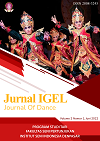Tari Bhairawapaksa, Interpretasi Sosok Mpu Barang
DOI:
https://doi.org/10.59997/journalofdance.v2i1.1575Abstract
Bhairawa is a force (group) who worships Durga as the supreme goddess in practice. Bhairawa is one of the most influential sects for Balinese people both in terms of spiritual practice and history. One of the stories related to the teachings of bhairawa and is well known to this day is the story of Mpu Barang. In the book Kajian Naskah Lontar Siwagama, Mpu Barang is described as a powerful Budha priest who can feed wandering spirits by eating his rough body until it runs out, the magic that Mpu Barang has is Bhairawapaksa. Mpu Barang's magic made the stylists interested in creating contemporary dances with horror nuances by using the theory of imagination so that they can freely interpret the cannibalism of the Mpu Barang character. In the process of realizing this dance work using the creation method proposed by Alma M. Hawkins, which consists of 3 stages, namely exploration, improvisation, and formation.This dance work, the stylist gives the title Bhairawapaksa Bhairawapaksa is a contemporary dance that is danced by 7 core dancers as a representation of Sapta Kanda Pat and Sapta Angga and uses 5 additional dancers. The structure of the Bhairawapaksa dance consists of 4 parts that describe the magical, calm, disgusting, and religious atmosphere. The message to be conveyed in this work is not to judge something only from the outside, but to look inside.
Keywords: Bhairawapaksa, Horor, Kanibal Mpu Barang, and Contemporary

Additional Files
Published
Issue
Section
License
Copyright (c) 2022 Kadek Karunia Artha, I Ketut Sutapa, I Wayan Adi Gunarta

This work is licensed under a Creative Commons Attribution-NonCommercial-ShareAlike 4.0 International License.
Volume 2 Nomor 1, Juni 2022







